What Problems are Caused by Static Electricity?
What Problems are Caused by Static Electricity?
There are four main problem areas, each of which is explored in more detail below:
- Electrostatic Attraction and Repulsion
- Fire Risk – EX Areas
- Shocks to Operators
- Electrostatic Discharge (ESD) in Electronics
Electrostatic Attraction and Repulsion
This is probably the most widespread problem in the plastics, packaging, paper, textile and similar industries. It shows itself as product misbehaviour, sticking together, repelling each other, sticking to machinery, dust attraction on mouldings, bad winding and many other symptoms.
Coulomb’s law governs attraction and repulsion. Basically, it is an inverse square law. In simplified form:
| Force of attraction or
repulsion (in Newtons) |
Charge (A) x Charge (B) in Coulombs | |
| = | ------------------------------------------------ | |
| (Distance between objects in m) 2 |
Thus, the severity of the problem is directly related to the size of the static charge and the distance between the objects being attracted or repelled.
Attraction or repulsion follows the field lines of the electric field (often called flux lines when they represent force or displacement). If the two charges are of the same polarity, they will repel each other. If they are of different polarities, they will attract each other. If only one of the products is charged, it will cause attraction by creating a mirror-image charge in the non-charged products:
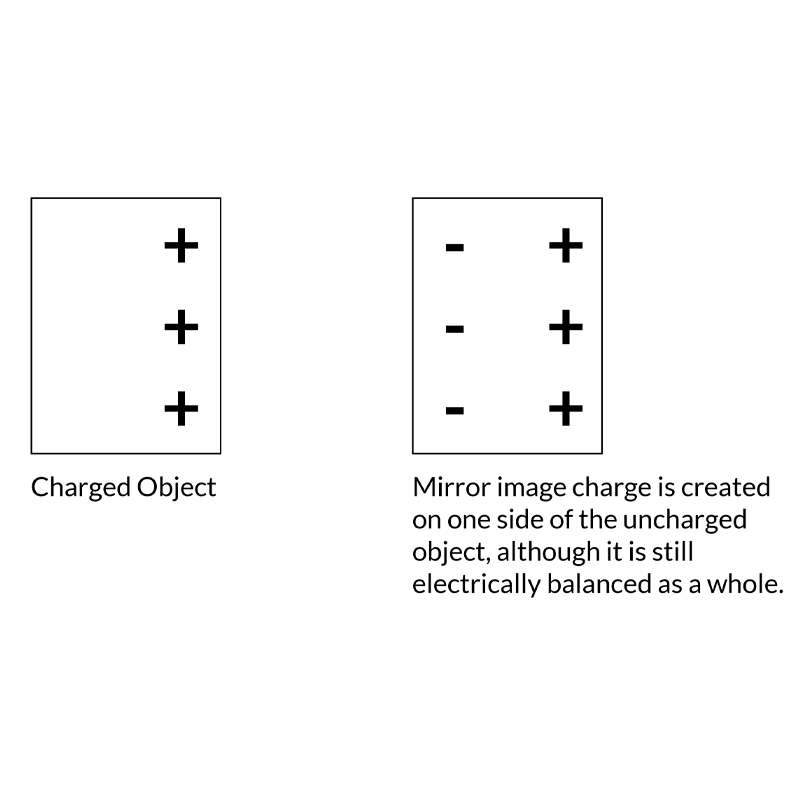
Fire Risk (EX Areas)
The risk of fire is very important in the coating, gravure printing and other industries where combustible solvents are used. The static charge on the film causes a spark discharge which ignites the solvent and creates a fire.
The following is a brief theoretical introduction into the ability of a static discharge to cause ignition in combustible environments.
The ability of a discharge to cause ignition depends on many variables:
- Type of discharge
- Source of discharge
- Energy of discharge
- Rate of discharge
- Presence of combustible environment - often a solvent gas, but can be dust or liquid
- Minimum Ignition Energy (MIE) of the combustible environment
Types of Discharge
There are three relevant types of discharge:
- Spark - usually comes from a reasonably conductive body which is isolated electrically. This could be a human body, machine part or tool. It is assumed that the entire energy is dissipated in a spark. If the energy is more than the Minimum Ignition Energy (MIE) of the solvent vapour, then an ignition could occur. The energy in a spark is calculated: Energy in Joules = ½CV2.
- Brush Discharge - usually happens when a corner of a machine part concentrates the charge in a larger sheet or web of non-conductive material. Generally lower in energy than a spark and so less incendive.
- Propagating Brush Discharge - occurs on highly resistive plastic sheets and webs where there is a high charge density of the opposite polarity on each side of the material. This may be caused by rubbing or powder coating bombardment. The effect is like discharging a plate capacitor and can be more incendive than a spark.
Source and Energy of Discharge
Size and geometry are important factors. The larger the body, the more energy it can contain. Sharp points increase field strength and encourage discharge.
Rate of Discharge
If the body holding the energy is not very conductive, e.g. a human body, the resistance will slow the discharge and reduce its danger. For the human body the rule of thumb is that it should be regarded as capable of igniting all solvents with a Minimum Ignition Energy (MIE) of less than 100 mJ, even though 2 or 3 times this energy is stored in the body energy.
A corona discharge has not been considered here. It is a slower, low energy discharge from a point. It is only regarded as problematic in the most sensitive areas.
Minimum Ignition Energy (MIE)
The Minimum Ignition Energy of the solvent and its concentration in the hazardous area are important. If the MIE is less than the discharge energy a fire could result.
Other sources of ignition in hazardous areas are ungrounded operators and floating conductors. An operator walking through a hazardous area in training shoes or similar non-conductive footwear risks a discharge from his body which can cause ignition to sensitive solvents. An unearthed and conductive piece of machinery is similarly dangerous. Good earthing is essential for everything in a hazardous area.


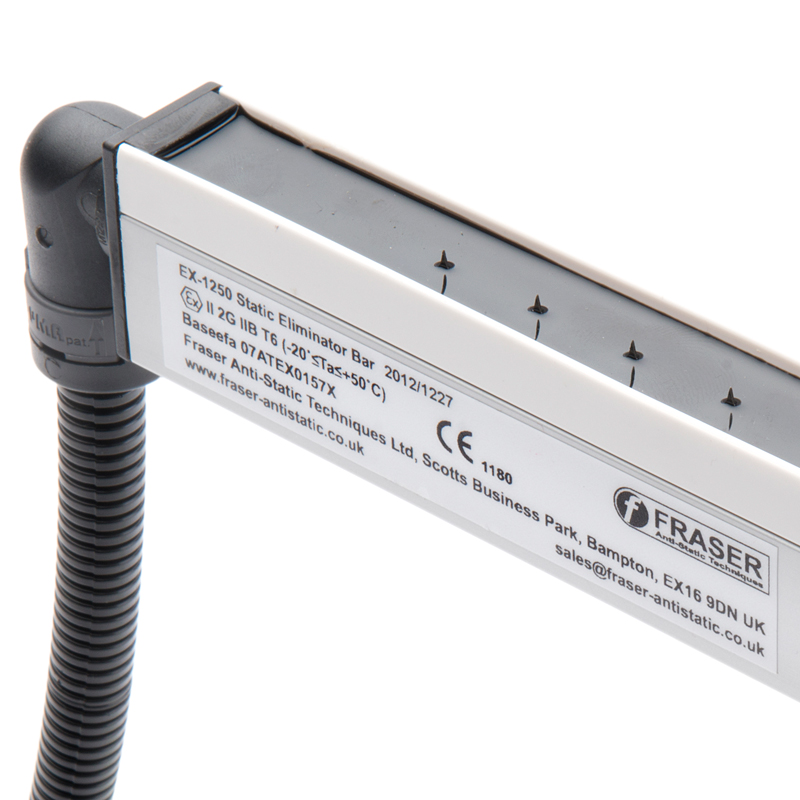
Shocks to Operators
Shocks to operators are becoming more important as health and safety issues increase in importance and scope.
Static shocks are unpleasant, but not usually dangerous, unless they cause a recoil reaction that propels the operator into machinery or the path of an oncoming vehicle. There are 2 common causes:
- Induction charging
- Shocks from the product
Induction Charging
If a person is standing in the electric field of a charged object, such as a winding reel of film, their body may get charged by induction.
The operator becomes charged, this charge stays in the operator’s body (if they are wearing insulative shoes) until they touch an earthed part of the machinery. Then the charge will zap to earth giving the operator a shock.
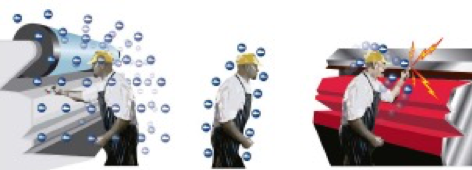
This happens also when the operator is handling charged objects and materials - the charge builds up in the body because of insulative shoes.
When the operator touches a metal part of the machine the charge can escape and cause a shock. The shocks that result from people walking over nylon carpets are due to the static generated between the carpet and the shoes. The shocks which car drivers receive when they get out of a car are due to the charge generated between the seat and the driver’s clothes as they are separated. The solution to the latter is to touch a metal part of the car, such as the door frame, as the driver leaves the seat. This allows the charge to go to earth through the car and its tyres without giving a shock.
Shocks from the Product
It is possible, but less common, for an operator to receive a shock from the material.
If there is a very big charge in a winding reel, the operator’s fingers could concentrate the charge until it reaches its breakdown point and forms a discharge.
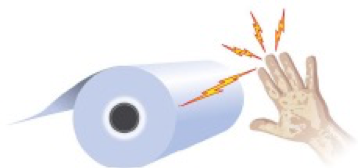
Alternatively, if there is a metal object which is not connected to earth standing in an electric field, it can become charged by induction. Because the metal object is conductive the charge is mobile and will discharge to a person who touches it.
Download Solutions to Static Problems – Shocks to Operators
Electrostatic Discharge in Electronics
Controlling static electricity is important when handling electronic assemblies and components on modern control systems, including RFID tags and labels. In electronics the problematic levels of static electricity can be very small - just a few volts, compared to the thousands of volts which are typical in other industrial applications. This requirement for balanced ionisation makes many normal industrial static eliminators unsuitable.
Often the danger is from the static charge in the human body - which can be considerable. This is why people in electronics assembly wear wrist straps - the wrist straps drain the static charge in the body. Ionisation equipment is used to neutralise the charge in other products and materials where earthing is not applicable - including non-conductive materials.
The current in the discharge from the human body or other object generates heat which evaporates junctions, interconnects and the gap between tracks in the electronic components. The high voltage also breaks down the thin oxide coatings on MOS and other coated devices. This causes failure of the product.
Sometimes the component is not completely destroyed which can be even more problematic as the failure will occur later when the product is being used.

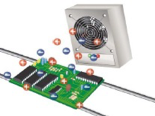
General rule: make sure that the body or other products do not contain a static charge when handling or being close to sensitive components.
This requires a combination of earthing and ionisation. There is a European and International standard covering the handling of sensitive electronic components: EN / IEC 61340-5-1:2016.
Find out more about Fraser's range of ESD anti-static solutions here.
Last Updated: 27 November, 2020